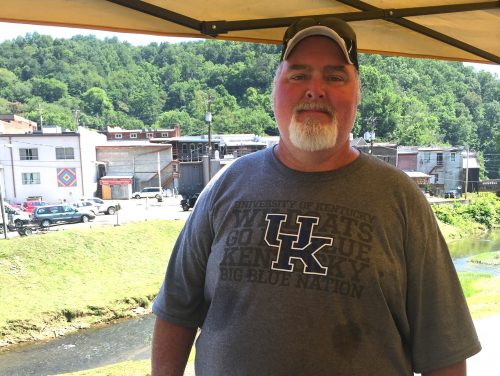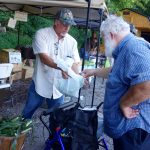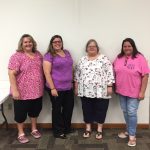
Another story in our series, Prevent Diabetes EKY, this report focuses on an innovative health improvement program happening in connection with the City of Whitesburg/Letcher County Farmers’ Market. We hear from participants, some diagnosed with diabetes or prediabetes, who walk one mile on the city’s public walking track every week and, in return, get a free $10 voucher to use on fresh fruits & vegetables at the market. The program has shown demonstrable results, including lowering participants’ average A1C levels and reducing waist circumference & BMI. It could serve as a model for other communities in the region struggling with increases in diabetes among residents.
Click here for the full transcript of this story:TRANSCRIPT
{Valerie Horn} Debbie, are you in the walking program? {Debbie Owens} Yes. {Valerie} Look at this. [thud] {Debbie} I got me some green onions, and taters for my pork roast, and some cabbage, cooked cabbage… I wanted some green beans for dinner tomorrow but they didn’t have any! {Valerie} I know…
NARRATOR: On a blazing hot Saturday morning this past summer, Valerie Horn was set up under a tent at the Letcher County Farmers Market in Whitesburg, Ky. She was checking in members of the Tanglewood to Table walking program. Her friend Debbie Owens was one of these participants.
{Debbie} I eat different vegetables now, I try different stuff. Like, fresh mustard greens and stuff— I never did eat it ’til now. So, it’s really good. It’s a lot better than out of a can! (laughs) I’ve got more energy, it seems like, [when] I walk. It might be with the vegetables and walking, too.
NARRATOR: If you’re trying to prevent type 2 diabetes, health workers say that, in many cases, the best medicine could be just what Debbie said: vegetables and walking. Given the high rates of prediabetes and type 2 diabetes in eastern Kentucky, WMMT set out to learn more about Whitesburg’s Tanglewood to Table program, and to see if it could perhaps be a model for other local communities, as a way of getting people moving more, eating healthier, and maybe even lowering their blood sugar.
{Valerie} I’m pretty fascinated and amazed some days just to sit back and see what is happening.
NARRATOR: Valerie Horn is from here in Letcher County, and she serves as the co-chair for the Farmers Market. The market happens downtown, right next to the public Tanglewood Wakling Trail, and back in 2016, Valerie had the idea to try to get more people to the market, and get them exercising, at the same time.
{Valerie} We began the walking program three years ago. The first go-around was pretty simple: we just said if you walk to the market on this Tanglewood Trail—about a one-mile trail that comes into here—then you would have $10 to spend at the market.
NARRATOR: The basic idea is still the same: you sign up at the beginning of the market season, and if you walk one mile every week, you get $10 that week to spend on fruits and vegetables at the market, which happens twice a week from June to August, and then once a week through October. The Walking Program is grant-funded; Marshall University funded year one, and now it’s supported by the University of Kentucky. So, there is a cap on how many people can sign up. But Valerie says those who do tend get pretty committed.
{Valerie} This week he have 63 participants who are signed up for the program. 55 have shown up. And I can look at the names who are missing and think ‘Oh yeah, I saw they’re on vacation,’ ‘Oh yeah, I know this one’s been sick…’ So I think it speaks well when 55 of 63 people, they’re showing up to walk for a $10 incentive.
{Dawn Brewer} Eastern Kentucky is just typically known for health disparities: the rates of diabetes, obesity, cancer…
NARRATOR: Dawn Brewer is a researcher at the University of Kentucky. She and Valerie are co-investigators into the Walking Program’s impact on community health.
{Dawn} Her idea— it hits on just these two huge public health challenges, which is: as Americans, we tend to consume few fruits and vegetables, and we’re physically inactive. So she had this program idea that is hitting both of those, that have such huge benefits to health. And so many of these chronic diseases that affect eastern Kentucky.
NARRATOR: So you’ve probably of diabetes, but also among those diseases that affect Eastern Kentucky is prediabetes. Which, basically, means your blood sugar levels are high enough that you’re officially in the danger zone for type 2. What’s tricky about prediabetes is that the symptoms are often hidden— in fact, the federal CDC says one out of three Americans has prediabetes right now, whether we know it or not.
But health workers say that even if you do have prediabetes, it is still possible to make changes that can slow or even prevent type 2. Even if it runs in your family. And the Walking Program sits right in the middle of those changes.
{Dawn} Genetically, you might be predisposed to it, but that does not mean you’re going to develop diabetes. There are so many things that you can do—a healthy diet, healthy weight, physical activity—so then you don’t develop diabetes.
{Christie Green} The two biggest things, really, are the diet and the exercise.
NARRATOR: This is Christie Green, Public Health Director at the Cumberland Valley District Health Department in Clay County, Ky. She is also works with Clay County’s Diabetes Prevention Program, a lifestyle change program where people meet in small groups over the course of a year to work to prevent type 2. Christie says that, yes, diabetes is preventable with healthier choices. But in order to make those healthy choices, you have to have them available to you. Which, she says, isn’t always the case in eastern Kentucky.
{Christie} I would say there is still more work that needs to be done in many communities in our region, looking at how walkable our communities are, what types of facilities we have, and our access to fresh foods. In some areas, we have very few grocery options, and dollar stores and those kinds of things, which do have groceries, but are frequently the kind of processed, calorie dense foods. So, that’s one of the biggest challenges for individuals who want to make a lifestyle change, is: if there aren’t facilities available for them to exercise, or if there’s not easy access to fresh food, then what?
{Mary Beth Castle} And where we live, economically, we don’t have a lot of job opportunities for people either.
NARRATOR: Mary Beth Castle is also a facilitator with the Diabetes Prevention Program, she at the Johnson County Health Department.
{Mary Beth} And you ask people who may be prediabetic, that [are] living on mininum wage, that they need to eat more fruits and vegetables, and those kinds of things, and they start looking at the cost of those versus a bag of chips that’s a lot less: they have to eat. And they’re gonna buy what they can afford to eat.
NARRATOR: So the walking program tries to make healthy food more accessible, and more affordable. But exercise is the other side of the coin in preventing diabetes, and it can also be hard in the region. For one, as Christie mentioned, many local communities don’t have accessible or affordable places to exercise. But also, for a lot of us, exercise is just plain hard. Especially if you’re going it alone. Here again are Valerie and Dawn.
{Valerie} We offer a time that you can meet as a group and walk together. But we also make room for people who want to walk as a family, or they gather and they meet with their friends…
{Dawn} …And then it doesn’t seem like, [in a sad voice] ‘I’m going to the gym.’ You know? It’s like—that’s hard. But instead it’s, ‘Yeah, we’re getting together on a Saturday or Thursday evening’… it’s not necessarily just to walk. The social aspect is so key to it, and it provides that support system. And that is exactly what we want to do, and foster, is that change in mindset, and that culture.
NARRATOR: So, is it working?
When it comes to type 2 diabetes, Valerie and Dawn say they’ve seen several improvements that are associated with the disease: in 2017, participants, on average, increased HDL (or “good” cholesterol), decreased LDL (or “bad” cholesterol), and decreased A1C levels, which is a measure of blood sugar in the body that goes hand-in-hand with diabetes. In 2018, there wasn’t the same average A1C decrease, but average waist circumference and body mass did decrease, and many individuals did still lower their personal A1C levels that year. They also found that people were eating exponentially more fruits & vegetables by the end of the program.
But also, apart from the hard data, and maybe most importantly, when it comes to long-term behavior change: people just seem to enjoy it.
{Bob Smith} I make sure I sign up every year, I don’t wanna miss it.
NARRATOR: Bob Smith is a teacher from Whitesburg, and he was one of several walkers we met on the day we visited the market. He says he was diagnosed with type 2 diabetes about 20 years ago.
{Bob} I’m 61, and I’m in better shape in my sixties than I was in my fifties. And a lot of that is because of this program. My blood sugar level went from a 9-point-something down to a 6.1. So almost, like, not diabetic. But I mean, that’s with my medication, and the walking, and trying to watch what I eat.
You know, you have to jot down your mileage and stuff each day you walk with this program, so it kind of makes you feel accountable. Like, I walk these stairs up here by the old high school, and the hills and things… I like to do that, instead of just level ground. I think I could walk all day. I know I probably couldn’t, but I feel like I could!
{Loran Sturgill} Well, you’ve got two choices. You either exercise, or you take a shot. I’d rather have exercise than a shot.
NARRATOR: Loran Sturgill is also from Letcher County, and he helps organize the walkers every week. He also participates himself, and he says he had no idea he needed to worry about diabetes until getting an A1C, or blood sugar, test a few years go.
{Loran} My A1C was over 7 when I started the program the first year. And at the end of the program it was 5.3. And I also lost about 25 pounds doing it also. I feel like a new person!
And, you know, you don’t think you’re exercising, because you’re talking as you go. Because man, if I focus on the exercise, I’ll not make it halfway down the track. But then if my mouth’s a-running, I can walk to the end of the county.
{Hillary Bank} What are you eating, Cole? {Cole} Blueberries. {Hillary} What’s your favorite thing at the Farmers’ Market? {Cole} Blueberries.
{Hillary} I’m Hillary Bank and I’m from Mayking, Kentucky.
We wanted to do the Walking Program because of Papaw, because he’s getting older in age. And it’s actually helped him a lot: he’s been cutting his own grass since we started walking, so he’s getting his exercise in. And we’ve actually lost a couple pounds and that doesn’t hurt, does it? (laughs) And the kids love it. They want to walk every morning, and they definitely look forward to Saturdays, to come to the farmers market. (laughs)
Let’s go eat our blueberries and see what else we got!
{Kayla Morton} My name’s Kayla Morton, and I’m from Whitesburg, Kentucky.
It’s very expensive to eat healthy. So, I would do it when I could, but sometimes it was just cheaper and easier to eat whatever. And this has definitely made it a lot easier for us to eat healthier, and, you know, find better foods for the kids.
I feel like it’s improved my health quite a bit, and it makes me more motivated to do it outside of the walking program as well.
NARRATOR: So, it should be said that the Walking Program isn’t the only special thing that draws people to the Letcher County Farmers Market. There’s also the Farmacy program (and that’s pharmacy with an F), where doctors can basically “prescribe” free farmers market vouchers for people with a range of health issues, including diabetes. There’s also a community kitchen that feeds people year-round, a summer feeding program for local youth, and a series of free concerts that happen on Market Thursdays over the summer, among other happenings. So, is Whitesburg a special case? Or would the walking program be worth trying in other places, too? Here again are Dawn, Christie, and Valerie.
{Dawn Brewer} Truly, what you need is people that are interested. It’s a pretty simple model to implement. And where you’re only given $10, and you can see some positive health markers, you can see behavior change: that’s a little bit of money that goes a long way.
{Christie Green} Especially, you get rewarded for walking a mile? That’s awesome. If we can move that needle around social norms, or around ease of access, then we really improve a lot of people’s health overall.
{Valerie Horn} I have grandchildren that are six and two years old, and I want them to have a community to grow up in that they see health as a priority, and taking care of themselves as a priority. And I want them to have choices for better work options. And I know—I believe—that food and health is a core, is at the base of that. So, I feel right now encouraged. I feel that we are shifting.
And if we can make a difference in our community, then these programs and these opportunities can be replicated in other communities across eastern Kentucky, Appalachia: I’ll be very pleased, very excited.
NARRATOR: For more on the Tanglewood to Table Walking Program, you can head to letchercountyfarmersmarket.com, or you can find the market on facebook. You can also call Valerie Horn at (606) 634-9468.
Another local option for trying to prevent type 2 diabetes is the Diabetes Prevention Program, a lifestyle change program developed by the CDC that’s currently being offered at: The Kentucky River District Health Department, Juniper Health, the Clover Fork Clinic, the Johnson County and Clay County Health Departments, and online. And finally, for a short quiz to see if you might be at risk for prediabetes, check out doihaveprediabetes.org. For WMMT, I’m Parker Hobson.




